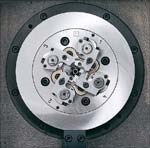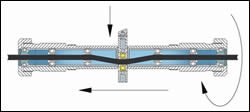A Different Way To Turn
The Esco concept turns turning 180 degrees. Unlike conventional lathes, the material, which is coil stock or bar from 0.02 mm to 12 mm, does not rotate. Stationary stock allows the use of round and profiled material.
Back in the late 1940s, Willy Rosetti, a Swiss parts maker, had a problem with a burr on a watch part he was attempting to produce. Conventional radial-fed cut-off tools generated the burr that subsequently had to be filed.
To address this problem, Willy came up with a new turning idea we now call the Esco concept, which evolved into the Escomatic machine tool line. About 50 years later, more than 10,500 installed machines give testimony to the viability of the concept.
The Esco concept turns turning 180 degrees. Unlike conventional lathes, the material, which is coil stock or bar from 0.02 mm to 12 mm, does not rotate. Stationary stock allows the use of round and profiled material.
The stock is held in place by a feed roller and guide bushing arrangement, while a rotating tool head removes metal. As the head spins, two, three or four cutters feed into the stationary material creating the designed part geometry.
Actuation of these cutters is by cams or CNC servomotors. Depending on the machine model, maximum head rotational speeds run from 8,000 rpm to 12,000 rpm. To overcome the significant centrifugal force generated at these speeds, the toolholders pivot into the stock through an arc rather than a straight radial feed motion. In another nod to centrifugal force, the cutters are set very close to the stock. A production benefit is that such short tool travel reduces non-cutting time.
For material up to 6 mm in diameter, it is necessary to straighten the incoming coil before it is fed into the rollers and guide bushing. A rotating straightener is standard on the Esco machine line. It revolves around the stock, cambering and straightening the wire by a combination of three movements applied to the stock. For material from 6 mm to 9 mm in diameter, a roller straightener is available.
After the machining cycle is complete, a counter collet supports the machined parts for cut off. Supporting the machined part during this operation produces a flat clean end eliminating the pip (unwanted material often created by conventional cut-off operations).
All of the machines in the Escomatic line employ the Esco concept for production turning of components. The line diverges when it comes to backworking, drilling and other additional operations needed for more complex parts in a single handling. Here, the goal is to match machine capability with the requirements of varyingly complex applications to achieve high speed, high volume production of complete machined parts.
— Tornos Technologies U.S. Corporation
Related Content
-
Planning for Growth Amid Uncertainty
Six strategies to maximize a company’s success amid unpredictability.
-
5-Axis Machining Centers Transform Medical Swiss Shop
Traditionally a Swiss machine shop, Swiss Precision Machining Inc. discovers a five-axis machining center that has led the company to substantial growth. (Includes video.)
-
Taking the Complexity out of Swiss Machining
How machine shops become more efficient with offline CAM programming, featuring toolpath generation, built-in simulation, multichannel control, proven postprocessors and seamless Solidworks integration.





















